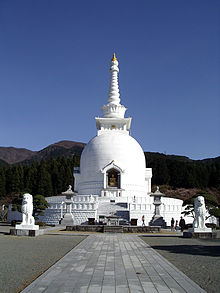Nipponzan-Myōhōji-Daisanga
Nipponzan-Myōhōji-Daisanga ( Japanese 日本 山 妙法 寺 大 僧伽 ) is a Japanese Buddhist group that emerged from the Nichiren movement and comprises around 1,500 monks, nuns and lay supporters and was founded in 1917. The founder of the Niponzan Myōhōji group was Nichidatsu Fujii ( 藤井 日 達 ; 1885-1985), who had been ordained at the age of 19. At the age of 33 he founded the Nipponzan Myōhōji Order. Later he was also known under the name "Guruji". In 1947 the construction of the first peace pagoda ( stupa ) began, the construction lasted 7 years and 100,000 people came to the inauguration. Many more peace pagodas built by the Nipponzan Myōhōji have followed since then.
The community, like every Nichiren school, worships the lotus sūtra (Japanese: Hokke-kyō ) as the highest expression of the Buddhist message. In addition, she is actively involved in the peace movement around the world . In 1982 the world peace movement was the largest and had the most supporters; Peace marches took place around the world, in which the then 98-year-old founder Nichidatsu Fujii took part. According to the SED newspaper Neues Deutschland , a president of the order was awarded the German Peace Medal in 1982. In 1988 another meeting with the GDR Peace Council took place. Their most popular action took place in 1994–1995 when they migrated from Auschwitz via Bosnia, Iraq and Cambodia to Hiroshima. The Nipponzan Myōhōji is based on chanting the title of the Lotus Sutra ( daimoku ) and beating a hand drum as a way to peace.
It has survived to this day (2007) (even if the number of participants in the peace marches has greatly decreased). So z. For example, a Nipponzan Myōhōji community from Tokyo to Hiroshima every year to take part in the commemoration of the atomic bombing on August 6th, on the way they speak to the rulers in town halls and submit their concerns to them.
Individual evidence
- ^ Stone, Jaqueline, I. (2003). "Nichiren's Activist Heirs: Soka Gakkai, Rissho Koseikai, Nipponzan Myohoji". In: Queen, Christopher, Prebish, Charles, Keown, Damien, editors (2003). Action Dharma: New Studies in Engaged Buddhism, New York, Routledge Shorton, p.77. ISBN 0-7007-1594-0 PDF ( Memento of December 4, 2013 in the Internet Archive )
- ↑ Christopher S. Queen. Engaged Buddhism in the West. Somerville, MA: Wisdom Publications, 2000, pp. 144. ISBN 9780861711598 .
- ↑ Robert Kisala. Prophets of Peace. Honolulu: University of Hawai'i Press, 1999. pp. 56
- ↑ New Germany Archive Edition from September 18, 1982
- ↑ New Germany Archive, edition from May 30th, 1988
literature
- Nichidatsu Fujii: My Non Violence: An Autobiography of a Japanese Buddhist, Japan Buddha Sangha Press 1975
- Nichidatsu Fujii: Buddhism for World Peace, Japan-Bharat Sarvodaya Mitrata Sangha 1980
- Nichidatsu Fujii, Yumiko Miyazaki: Bow to the Buddha in You: Dharma Talks and Writings of the Most Venerable Nichidatsu Fujii, Nipponzan Myohoji Publications 2009. ISBN 0979129818
- Tranquil Is This Realm of Mine: Dharma Talks and Writings of the Most Venerable Nichidatsu Fujii, Nipponzan Myohoji Publications 2007. ISBN 097912980X
- Margareta von Borsig (ex.): Lotos Sutra - The great book of enlightenment in Buddhism. Herder Verlag, new edition 2009. ISBN 978-3-451-30156-8
- Kubo Tsugunari, Yuyama Akira (tr.) The Lotus Sutra . Revised 2nd ed. Berkeley, Calif. : Numata Center for Buddhist Translation and Research, 2007. ISBN 978-1-886439-39-9 PDF (1.6 MB)
- Shinjo Suguro (1998): Introduction to the Lotus Sutra, Jain Publishing Company. ISBN 0875730787
Web links
- Official Website (Japanese)
- Tumblr (English)
- Dharmawalk ( Memento from January 1, 2006 in the Internet Archive )
- The official website for the Western, MA Nipponzan Myohoji Buddhist sangha

